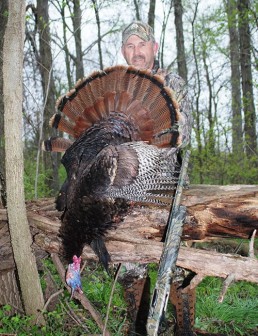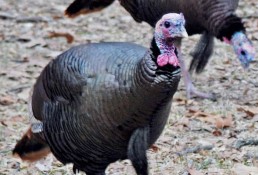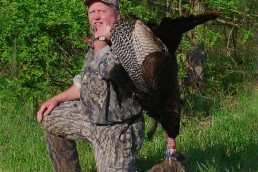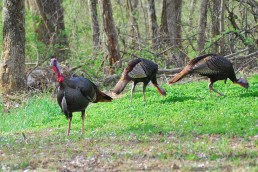The Art of Calling Big Ol’ Gobblers in Close
SHARE THIS POST
At 3 feet, the turkey’s head appeared as ugly as sin. Wild turkeys are a colorful, beautiful bird, but more so at a distance. Inside 10 feet the birds take on a ghoulish look. The grossly wrinkled head, the baggy waddles and that stretchy nosepiece called a snood is something out of science fiction.
However, there seems to be a trend in today’s turkey hunting crowd to miss these up close, in the face encounters with wild turkeys. Modern technology has replaced the close encounter with super magnum guns that fire super-charged shot shells amazing distances. Then, many modern hunters, who prefer success over experience, stretch the envelope and attempt to kill turkeys at distances approaching the length of a football field. Really.
I recently had an acquaintance tell me that a friend of his killed a gobbler at 82 yards last year. The first thought that popped into my mind was: how sad. That hunter probably not only wounded several birds before getting lucky and he missed the hunt part of the hunting experience, calling that bird in close.
Besides the inherent problem of ethics, when it comes to shooting at turkeys beyond the intended and acceptable distances, hunters are cheating themselves out of the most enjoyable part of the turkey hunting experience: calling them in close.
Patience used to be lauded as one of the most important elements of turkey hunting. The old-timers taught us to yelp three times on a box call, sit it down, wait 30 minutes and do it again, and again, and again. Certainly, we have learned that other tactics work, but the basic truth is still important. Patience is a virtue, and a key ingredient to being able to call birds inside 30 yards.
Hunters need to start weeks in advance of opening day to hone their patience skills. Society is fast and demanding. Speed rules our lives. Highway speed limits are seldom good enough. People speed to work, to work for a boss who wants everything done yesterday. Kids ball games, social obligations, go here, go there, it all adds to the mentality of doing it quickly. Unfortunately, that mentality carries over into hunting experiences and can lead to frustrations in the field and at times promote the development of dangerous situations.
Scouting in advance of the season can greatly reduce stress in one’s life and provide the needed opportunity to slow down and observe. I certainly think one could call turkeys to within 82 yards without traumatizing them, just for practice. Calling should be kept to a minimum and calling birds in close should be saved for opening day.
When the season arrives, hunters must approach the hunt with the mental attitude that they want to enjoy every aspect of the hunt, not just the kill. Counting the gobbles heard rather than the yards of a shot adds inherent quality to the experience. Intentionally adding other enjoyable diversions to the hunt, such as picking a few morels, often slows the hunter enough to allow a gobbling bird to work its way toward the caller. Remember the 30-minute rule? It still works.
Experienced turkey hunters know that every day in the woods is different. The bird that proved difficult to hunt yesterday may be suicidal today. The call that worked like magic on turkeys last week may send birds fleeing this week. That is the magical stuff of turkey hunting. The challenge is one of the major factors attracting hunters to the sport. So, why not add the extra challenge of trying to call a turkey in close. The benefits of doing so include a rush of personal satisfaction, the advantage of learning far more about turkey behavior than if shooting long range, and a dramatic increase in safety. Those three factors should be the crux of what hunters expect from a turkey hunt.
Are you enjoying this post?
You can be among the first to get the latest info on where to go, what to use and how to use it!
The how of calling turkeys in close is no simple solution, another addition to the challenges of the hunt. Producers of turkey hunting videos and DVDs make great profits telling us how to do it. However, every turkey hunting star uses a different method. That technique sells their wares, but also makes a point. There is more than one way to skin a cat.
To call turkeys in close, I have gleaned some pointers from my 40 years of turkey hunting that work, sometimes. Foremost is gaining knowledge about where turkeys hang out. Scouting takes care of that. Learning the travel routes of the turkeys where you intend to hunt adds to success as well. Too, patience and observation are as crucial when scouting as when hunting.
Camo is important. Turkey hunters live by this rule. However, minimizing movement is just as important when attempting to draw turkeys in close. All adjustments should be made while a turkey is either turned in the opposite direction or behind some type of obstacle. Gobblers are unbelievably apt at detecting movement. Slight movements foil more close encounters with gobblers than most other factors combined.
Knowing distances is paramount to consistently harvesting wild turkeys. Few people are really good at it. Most think a bird is much closer than it actually is. Packing a range finder is wise.
How close is close? Play it by ear, to a point. To make consistent kill shots, birds should be allowed to approach within 30 yards. If the bird does not become suspicious, why not let it approach closer? It is good heart exercise. Also, the thrill of hearing a tom spit and drum as it attempts to attract the hen in the bush is the ultimate thrill while turkey hunting. Twenty yards, 15, 10… the heart beats faster.
I have had turkeys close enough to touch on many occasions. As friend Greg Hood, from Mississippi says, “I like to call ‘em in close enough to kill ‘em with a stick.”
I can’t wait until that season opens in Missouri.
Bill Cooper is an outdoor writer from the Missouri Ozarks, his favorite place to pursue wild turkey gobblers and catch stream-strong smallmouths. Contact: aoutdoorstv.com, facebook.com/outsidealways.
MWO
SHARE THIS POST
Did you enjoy this post?
You can be among the first to get the latest info on where to go, what to use and how to use it!
Bill Cooper
An inductee to the National Fresh Water Fishing Hall of Fame, Bill Cooper, from the Missouri Ozarks, has written over 4,000 articles on outdoor subjects. You can hear him on Wild at Heart Outdoor radio at espn1073.com.




